Design Museum Collection App:music
The Design Museum Collection App for iPad is now available to download, featuring interviews filmed by Dezeen with Design Museum director Deyan Sudjic about 59 objects from their collection. Download it free from the app store here.
In this film we've compiled extracts focussing on how design has shaped the way we listen to music over the last century, including iconic devices like the Ecko AD-65 radio from the early 1930s, SK5 Phonosuper from Braun in the 1950s and Sony's experiments from Walkman to Discman to MiniDisc towards the end of the twentieth century.
iPhone and Android versions of the app will be launched in the next few months. You can listen to Sudjic talking about classic design for driving in our earlier movie.
For original tracks by young and upcoming artists, check out the recently launched Dezeen Music Project blog.
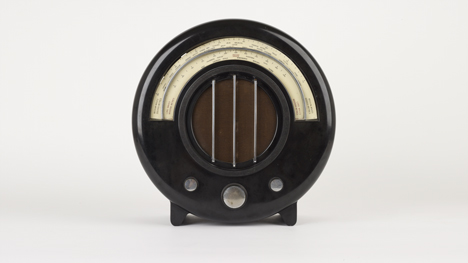
The following are excerpts from the app:
Ecko AD-65 (above)
In the early 1930s, Ecko, one of Britain’s largest radio manufacturers, adopted Bakelite, a new synthetic plastic created by Dr Leo Baekland in America. This had advantages in that it was cheaper to mass-produce, and when coupled with advances in technology, would lead to smaller radios. Early radio receivers had been large and looked like wooden furniture. To promote the use of Bakelite, the firm's founder E.K. Cole invited Modernist designers Serge Chermayeff and Wells Coates to challenge the usual ‘wooden box’ approach to domestic radio design. Wells Coates’ 1932 design was not only innovative in its use of material; but also in its appearance. Rather than hide the mechanism in an elaborate cupboard, Coates took his visual cue directly from the technology. The shape of the case was determined by the circular shape of the loudspeaker, which is further emphasised by the semi-circular tuning dial and round control knobs. It was available in black, brown, ivory and even lime green. Perhaps unsurprisingly, the most popular option was brown, which closely resembled the burr of walnut veneer.
The Ekco AD-65 not only celebrates the properties of Bakelite, but accords the radio with a form in its own right, rather than imitate an existing piece of furniture. Indeed, Coates’ iconic design would influence radio design for many years.
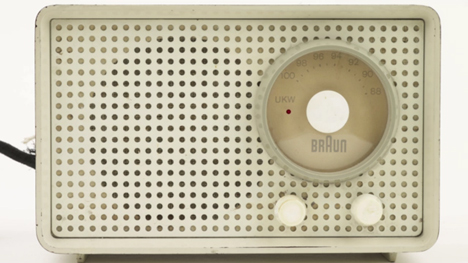
Braun SK 1 (above)
The 1955 SK 1 was part of a new range of Braun products that rejected the previous popular styling for domestic appliances. Instead of treating them as furniture and encasing them in wooden cabinets, Braun developed a new typology for household appliances.
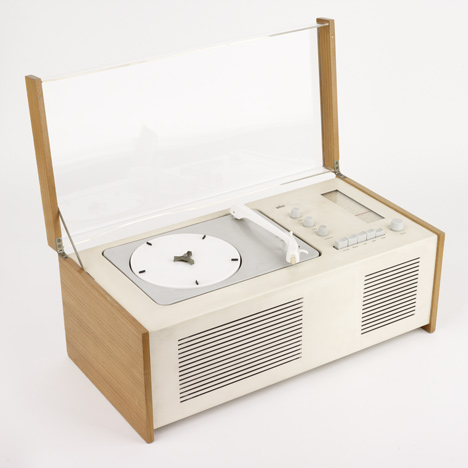
SK5 Phonosuper (above)
This revolutionary use of a clear Perspex cover was radical at the time in 1956, causing the product to be given the nickname ‘Snow White’s Coffin’. The SK5 Phonosuper defined a new aesthetic that became the archetype for turntables until records became obsolete.
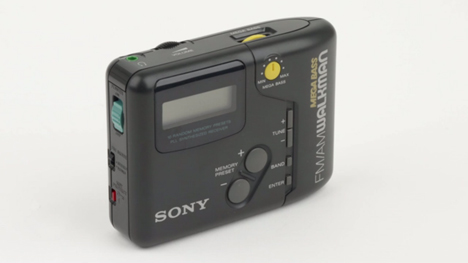
Sony Walkman SRF M45 (above)
The first Walkman, released by Sony in 1979, started a revolution in portable entertainment. While portable radios had been available for over 20 years, the cassette tape gave people the choice to listen to whatever they wanted in any location. Gone were the restrictions of a stationary player and the Walkman became part of popular culture and fashion. This 1992 version shows how the device changed with fashions with its smooth styling and ‘mega bass.’
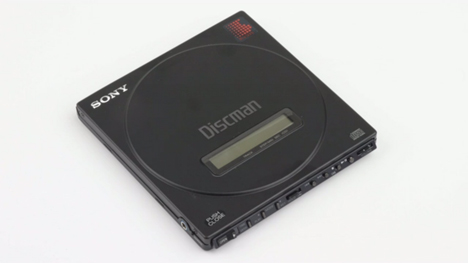
Discman D-50 MkII (above)
Popularly known as the ‘Discman’, the D-50 was the first portable compact disc (CD) player. Launched in 1984, the D-50 was approximately the size of four CD cases, and weighed 590g. Despite its small size, the D-50 required a large battery-pack case that exaggerated its claims of portability. Nonetheless, its real significance was in stirring public interest in compact discs at a time when cassette tapes were still the norm. Sold in Japan at a surprisingly low price (less than 50,000 yen), the D-50 put paid to the notion that CDs were niche products requiring large and expensive players. It would be some years before the cassette tape died out, but the D-50 made CDs accessible to the wider public.
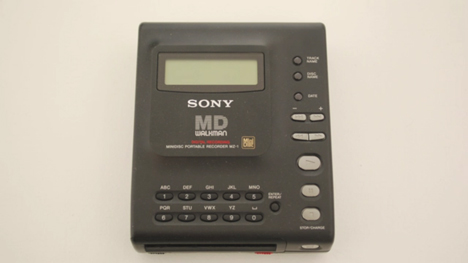
MZ1 MiniDisc
The success and benefit of cassette tapes and compact discs led to a need for a new audio device, one that combined the portability, record-ability and shock resistance of the cassette tape with the sound quality, random access and durability of the compact disc. Developed by Sony in 1992, the MZ1 MiniDisc Walkman was designed to combine the best qualities of both. Like CDs, MiniDiscs offered high quality sound, and like cassettes, they were also recordable. Once made, recordings could be divided, combined, deleted and named, all new experiences to those used to tape recording. The MP-1 introduced digital sound to the home user, and paved the way for MP3s and iPods.
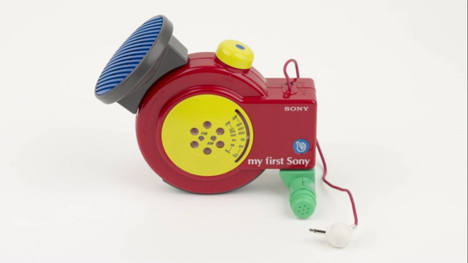
My First Sony (above)
Fresh from the success of the portable Sony Walkman, the Japanese electronics giant Sony turned their attention to the new, emerging children’s market. Called ‘My First Sony’, this was a range of childrens products that include this 1998 radio, a Walkman, an amplified microphone with a tape desk and headset walkie-talkies. The designers studied popular toys of the time to get inspiration for the range. The basic body is nearly always red, while speakers are yellow and functional parts are blue. Clear panels reveal internal mechanisms, so that wheels inside can be seen rotating. Buttons and dials are large and simplified, ensuring that children can easily operate the machine. The design of the product is not only aimed at children, but also at their generous parents. All edges are smooth and rounded, and the battery cover was made so that it could not be detached, eliminating a potential choking hazard.
The My First Sony range was enormously popular. However, the product launch was not without its difficulties. The electronics giant was accused of deliberately targeting children and teaching them how to be consumers. Indeed, the name of the My First Sony range belies the company’s ambition to not only spark a lasting interest in technology and consumer electronics, but also to launch a generation of future Sony customers.
The Design Museum Collection
The Design Museum Collection is made up by over 2000 objects that range from the early Modernism of the 1900s to the cutting edge of contemporary design. The Collection tells the history of design in mass production and includes furniture, lighting, domestic appliances and communications technology. The Collection is an important record of the key designs which have shaped the modern world.